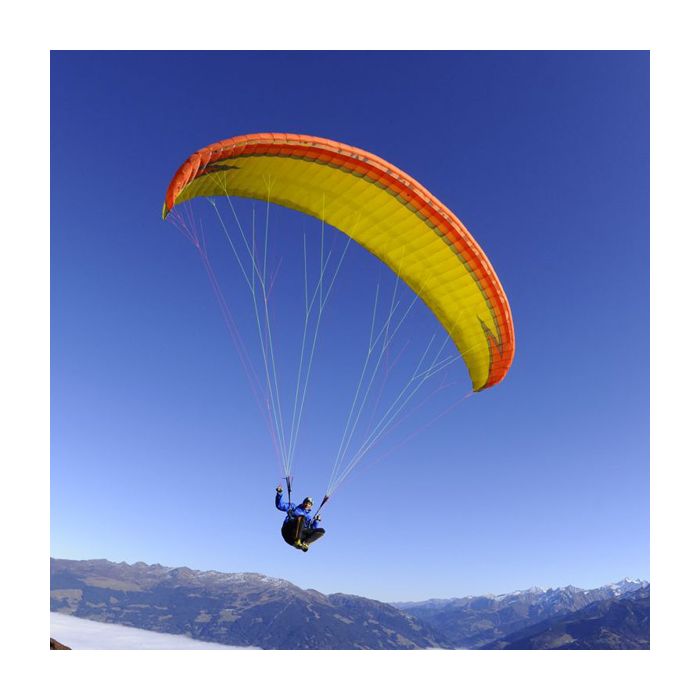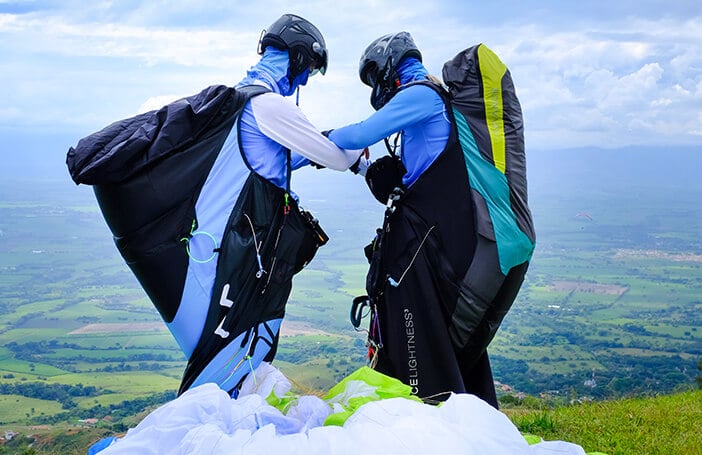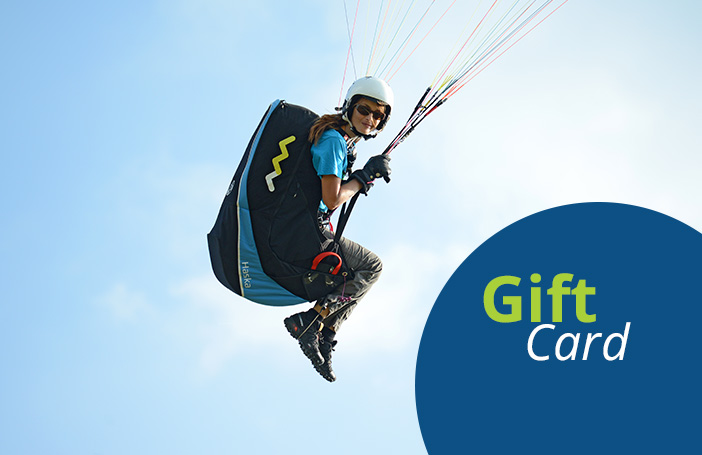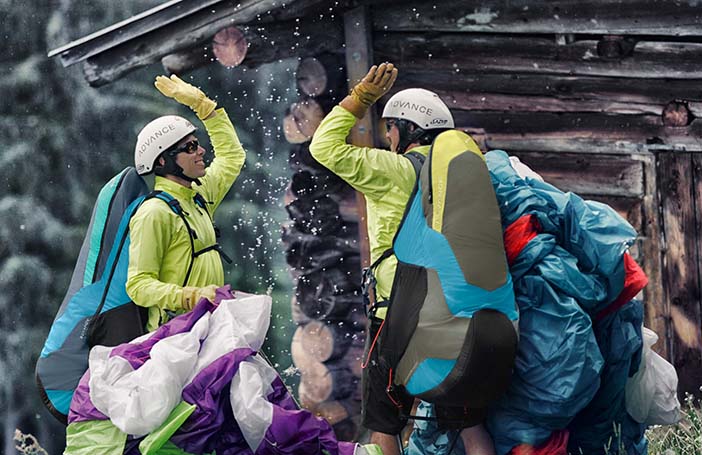
Nova Ion 2 (PAST MODEL)
Select all options to view stock availability

Nova Ion 2
Development:
Our demands for the Ion 2 were similar to the demands we made on the Mentor 2: Developing a glider which raises the bar in its class in terms of easily usable performance.
Because of the many design similarities we call the Ion 2 the little brother of Mentor 2.
For instance the airfoil is exactly the same and it ensures high performance and high stability, though with a very soft collapse behaviour.
Like the Mentor 2, the Ion 2 has just three line levels with a short split at the trailing edge for better handling characteristics.
Like on all our gliders we didn't want to improve the performance by increasing the aspect ratio, and therefore at the cost of safety. That's why the Ion 2 has the same aspect ratio as the Ion 1.
Flying the Ion 2:
The launch behaviour is extraordinary easy – even for a glider which is approved for schooling.
In flight, an Ion 2 pilot will immediately notice the very responsive handling characteristics. The Ion 2 reacts quickly to brake inputs which makes it easy to vary turning radius and bank.
In turbulent conditions the Ion 2 offers more resistance to collapses and small deformations. The result is the glider flies very stably through rough air.
The high stability also improves the turning behaviour:
The sluggish reaction to steering inputs, often a handling characteristic of low level wings, has been replaced by a very precise and responsive behaviour.
Like on the Mentor 2, the high level of stability doesn't decrease when flying accelerated. Because of the higher damping around the roll axis, the Ion 2 offers even more comfort when flying on full bar.
Safety:
The Ion 2 is well within the EN B class, so maintaining this category has never been a concern during development. The position of the A-suspension hasn't been changed from the Ion 1, that's one reason why the Ion 2 reacts quite similar to induced collapses. Of course the certification was done without folding lines.
The behaviour in turbulent conditions is way more important than what the wing does after induced collapses. That's why our test pilots spent many hours in turbulent air with the final prototypes to check stability and collapse behaviour.
A big part of those last test flights was done accelerated. The Ion 2 proved to be very stable at top speed. Combined with the high performance, pushing the speed bar makes absolutely sense. (Which cannot be taken for granted on a Low-Level B glider)
No matter if flying at trim speed or accelerated: The Ion 2 doesn’t tend to collapse over a large-area and it reopens quickly without impulsiveness. This soft collapse behaviour is beneficial as hard collapses and "explosive" reopenings frighten many pilots and leads to instability.
Performance:
The Ion 2 sets a new standard for Low-Level EN B gliders:
For instance, it clearly outperforms the Mentor 1 (which was good enough for numerous flights of more than 200km) at trim speed.
Comparing the performance of these two wings in accelerated flight is even more impressive, because the Mentor 1 disappears downwards surprisingly fast, from the Ion 2 pilots view.
Technical changes compared to Ion 1:
- New airfoil: because of the three line levels we needed a new airfoil. It stands out for its pitch stability, the big brake travel and a high collapse resistance.
- Integrated polyamide rods: These very sturdy rods replace the mylar reinforcements and lead to less weight and more stability. The rods don’t need any more care than the mylar reinforcements did!
- New accelerator: We've adapted the riser geometry of the Mentor 2 for the Ion 2, which leads to high stability, excellent glide performance and a soft collapse behaviour.
- More cells, less lines: The Ion 2 has 45 cells (Ion 1: 37) but significantly less line consumption. This leads to higher dimensional stability and less parasitic drag.
- Reefing system at the trailing edge: We're using this reefing system already on the Factor 2 and on our tandem the Bion, and it works on the Ion 2 as well: Despite the small number of brake lines, the trailing edge looks very clean when applying brakes. The reefing system reduces brake pressure and improves the turning behaviour.
Pilot's profile
The ION is approved for schooling, so of course we don’t make any demands on the pilot’s skills, but we would like to remind every pilot of the importance of individual responsibility at this point.
Every pilot, who flies on their own has to be able to decide if their skills and equipment is adequate for the respective conditions. The Ion 2 offers superior safety but even on such a glider with maximum passive safety, misjudgements may have serious consequences.
The best way to avoid misjudgements is a defensive approach to the sport. Some times it makes sense to pass on a flight, instead of getting yourself into conditions you cannot handle. Regular training improves your skills and enables you to enjoy your flights, even in more difficult conditions.
If you didn't fly for some time or if you are not familiar with a certain flying area, it makes sense to take professional assistance to increase fun and safety. In this regard we also recommend to attend a SIV course to get to know your glider and yourself better.
Please consider these thoughts!
ION 2-Hundred Challenge
ION 2-Hundred Challenge with minimum prize money of 4800 Euros.
Together with XContest.org NOVA introduces the ION 2-Hundred Challenge with some prize money: The first pilot to complete a 200+ km FAI triangle in the 2012 season will be awarded with 2000 Euros. In addition, the flight with the highest score during the entire 2012 season get the number of points multiplied by factor 10 in Euros.
Of course the flights have to be done with an Ion 2 and they have to be submitted to XContest.
In case, no one is able to fly further than 200km with an Ion 2 in 2012 we will donate 5000€ to the "Wings of Life" Foundation.
Technical Data
Type |
- |
XXS |
XS |
S |
M |
L |
|
Zoom factor |
- |
0.880 |
0.920 |
0.960 |
1.000 |
1.040 |
|
No of cells |
- |
45 |
45 |
45 |
45 |
45 |
|
Projected wingspan |
m |
8.23 |
8.65 |
9.06 |
9.40 |
9.78 |
|
Projected surface area |
m² |
19.05 |
21.06 |
22.94 |
24.88 |
26.92 |
|
Projected aspect ratio |
- |
3.55 |
3.55 |
3.55 |
3.55 |
3.55 |
|
Flat wingspan |
m |
10.77 |
11.33 |
11.82 |
12.31 |
12.80 |
|
Flat surface area |
m² |
22.67 |
25.05 |
27.28 |
29.60 |
32.02 |
|
Flat aspect ratio |
- |
5.12 |
5.12 |
5.12 |
5.12 |
5.12 |
|
Line diameter |
mm |
1 / 1.4 / 1.85 |
1 / 1.4 / 1.85 |
1 / 1.4 / 1.85 |
1 / 1.4 / 1.85 |
1 / 1.4 / 1.85 |
|
Line length |
m |
6.30 |
6.62 |
6.91 |
7.20 |
7.49 |
|
Line consumption |
m |
197 |
207 |
216 |
225 |
234 |
|
max. profile depth |
m |
2.63 |
2.76 |
2.88 |
3.00 |
3.12 |
|
min. profile depth |
m |
0.65 |
0.68 |
0.71 |
0.74 |
0.77 |
|
Weight |
kg |
4.9 |
5.3 |
5.7 |
6.1 |
6.5 |
|
Legal take-off weight |
kg |
60-80 |
70-90 |
80-100 |
90-110 |
100-130 |
|
take-off weight motor |
kg |
|||||
|
Places |
- |
1 |
1 |
1 |
1 |
1 |
|
Certification |
- |
B |
B |
B |
B |
B |
Colours
Standard Colours: Sunrise; Orange Flux; Green Fizz; Blue Moon.
Downloads
LTF/EN test reports: Ion 2 L, Ion 2 XXS, Ion 2 XS, Ion 2 S, Ion 2 M
| Condition | New |
|---|---|
| EN Certification | EN B |
| LTF Certification | LTF B |
| Model Status | Past model |
Standard UK delivery - £3.95 / FREE on orders over £100.
Outside the UK - delivery calculated at checkout (based on the total order value and your delivery address).
We use Royal Mail, Parcelforce Worldwide and other courier companies (e.g. DHL, DPD) depending on shipment value, weight, destination etc.
For more information, please view our order and delivery FAQs page.
If you are not 100% satisfied with your order, you have 14 days from the day of delivery to request a refund.
Delivery costs will not be refunded and you will be responsible for the delivery cost to return the order.
For more information, please read our returns and exchanges policy.



